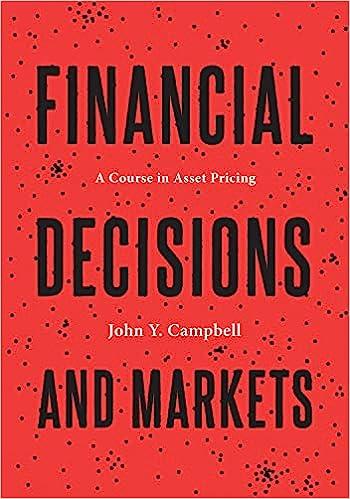Consider a model with two dates (t=1,2) and two agents. Agents receive income and consume only at
Question:
Consider a model with two dates \(t=1,2\) and two agents. Agents receive income and consume only at date 2. Agent 1 has income \(x_{1}=c+v+\varepsilon\), while agent 2 has income \(x_{2}=c+v-\varepsilon\). The term \(c\) is deterministic, while \(v\) and \(\varepsilon\) are independent, normally distributed shocks with mean zero. The variance of the common income shock \(v\) is 1 , while the variance of the relative income shock \(\varepsilon\) is \(a\). Agent 1 has constant absolute risk aversion coefficient \(\gamma_{1}\), while agent 2 has constant absolute risk aversion coefficient \(\gamma_{2}\).
A single futures contract exists in this economy. The payoff on the contract is \(\theta_{1} v+\theta_{2} \varepsilon\), and it costs \(p\) payable at date 2 . Normalize the variance of the payoff to 1 . (Note: this imposes restrictions on \(\theta_{1}\) and \(\theta_{2}\).) The contract is in zero net supply.
(a) Given the price \(p\), solve for the quantities of the futures contract \(q_{1}\) and \(q_{2}\) that each agent wishes to hold.
(b) Solve for the price \(p\) that must hold in equilibrium given that the futures contract is in zero net supply.
(c) Write down an expression for the maximized utility of each agent. Add the maximized utility of agent 1 to the maximized utility of agent 2 to get an expression for social welfare.
(d) Now assume that \(\gamma_{1}=\gamma_{2}\). Show that a futures contract designer who wishes to maximize social welfare will set \(\theta_{1}=0\). Interpret this result.
(e) Now assume that \(\gamma_{1}=0\) while \(\gamma_{2}>0\). Show that the welfare-maximizing contract designer will set \(\theta_{2}=-\theta_{1}\). Interpret this result.
(f) Now assume that \(\gamma_{2}=0\) while \(\gamma_{1}>0\). Show that the welfare-maximizing contract designer will set \(\theta_{2}=\theta_{1}\). Interpret this result.
(g) What assumptions would be needed for the welfare-maximizing contract to have \(\theta_{2}=0\) ? Explain.
Step by Step Answer:

Financial Decisions And Markets A Course In Asset Pricing
ISBN: 9780691160801
1st Edition
Authors: John Y. Campbell





